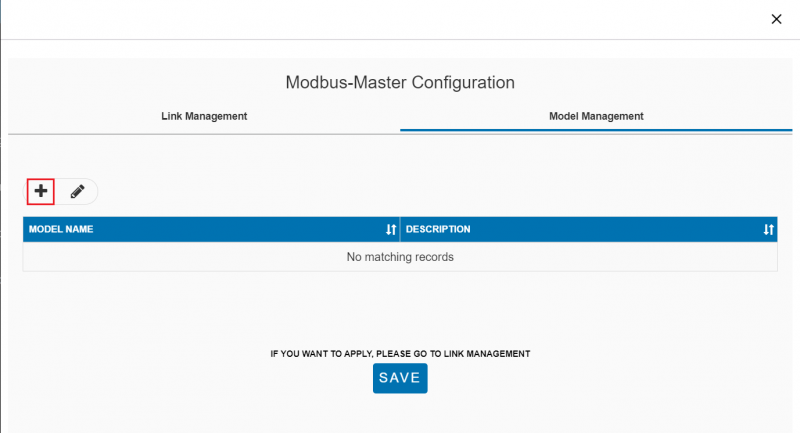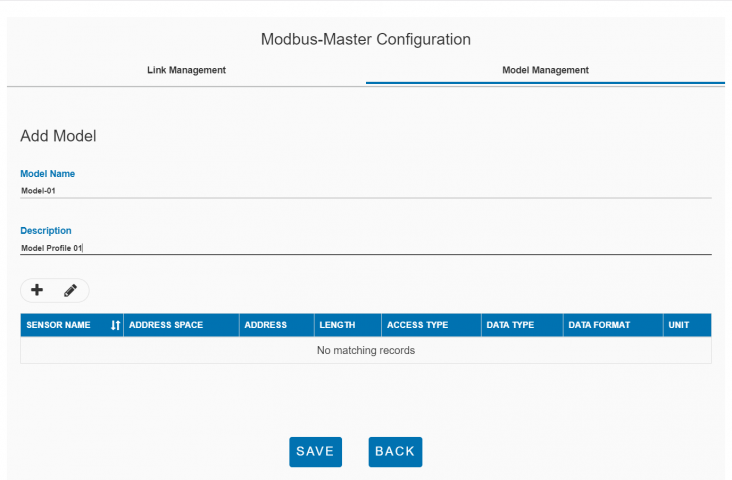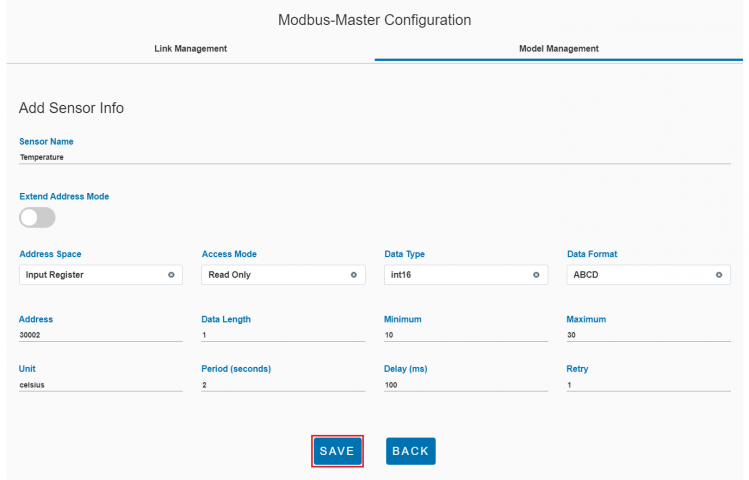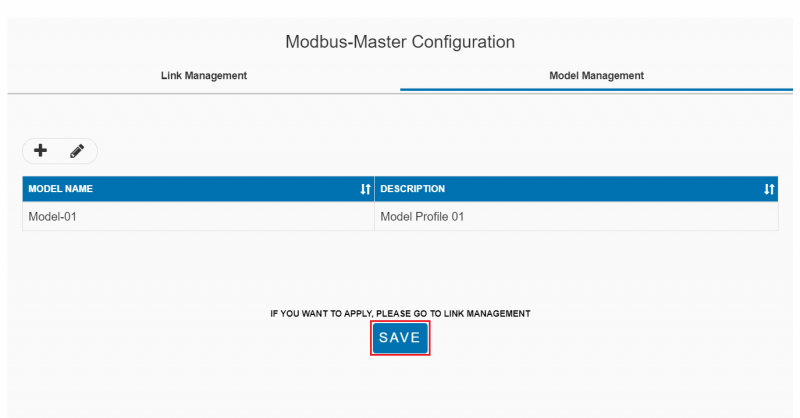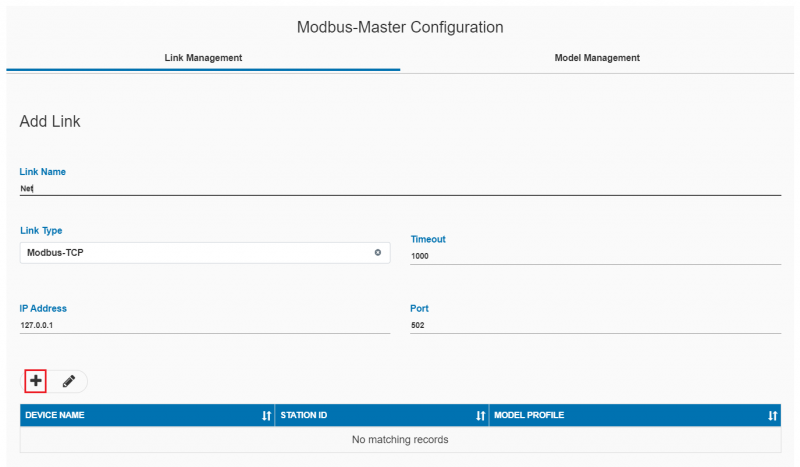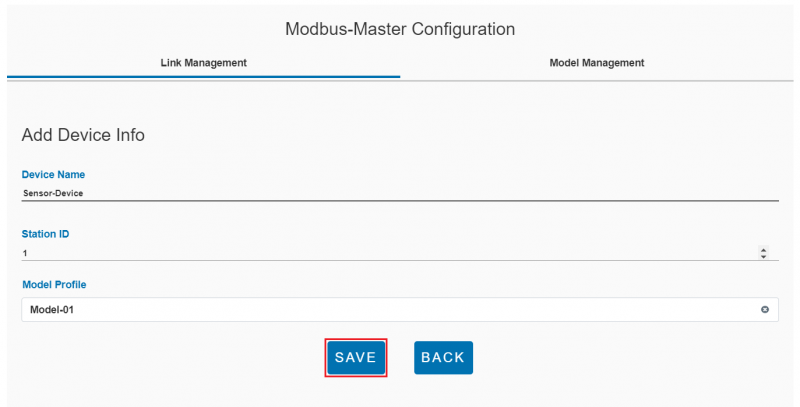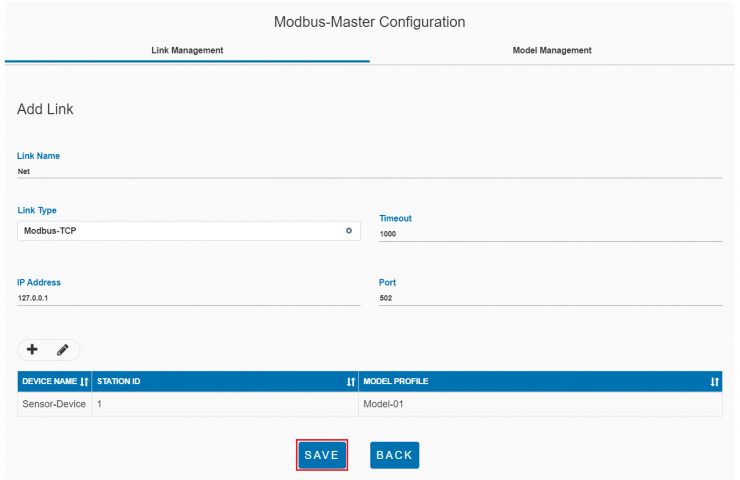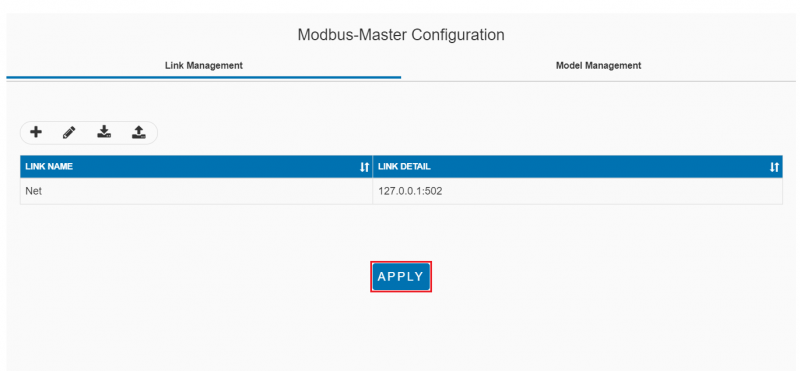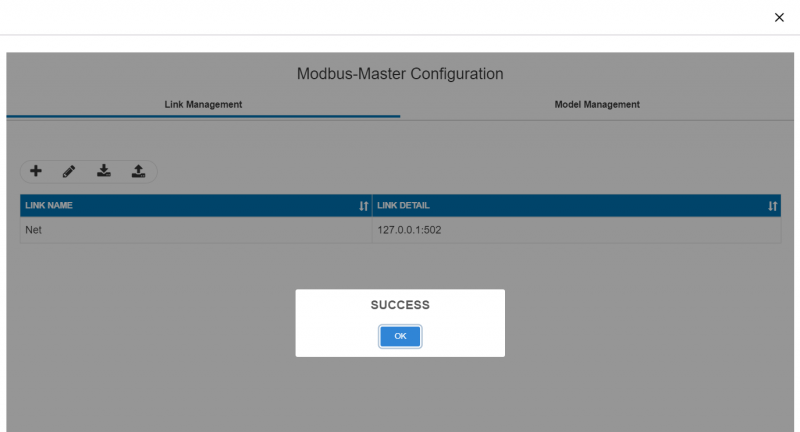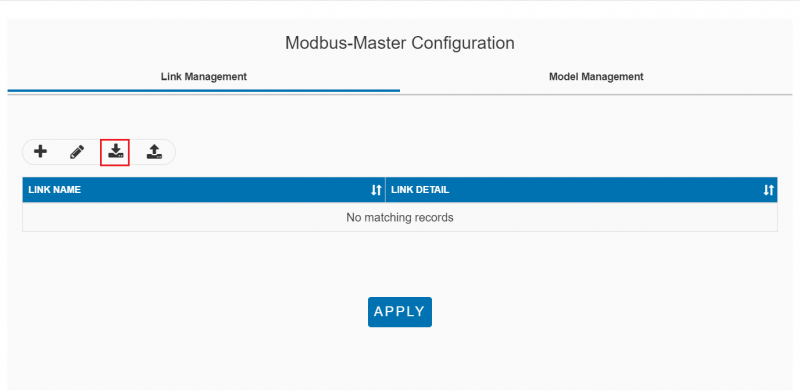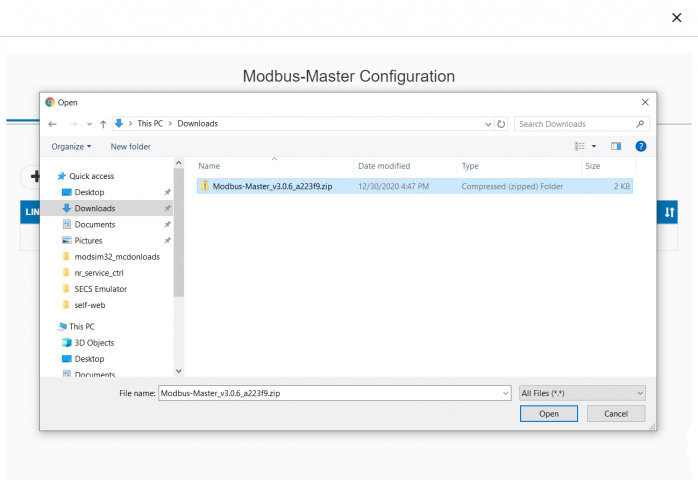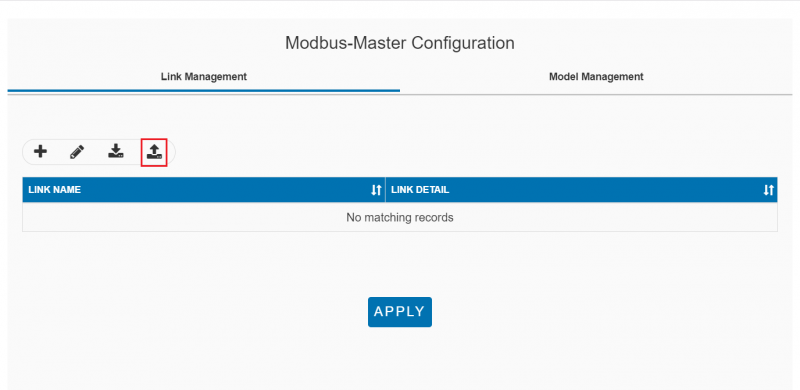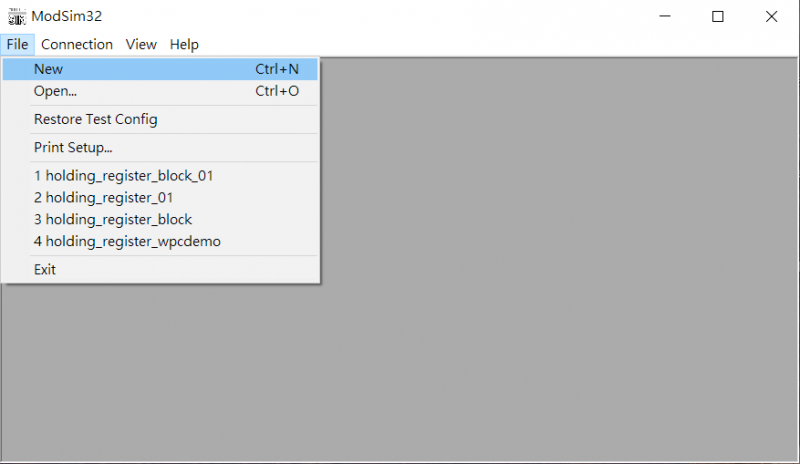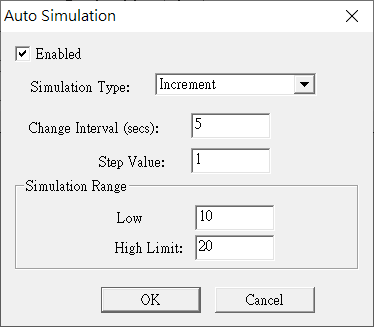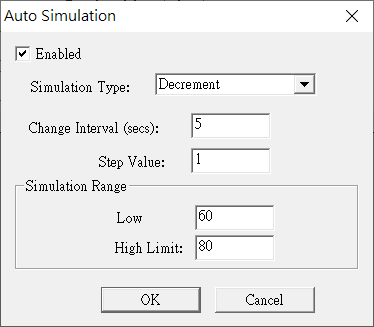Difference between revisions of "Modbus Master"
| Line 51: | Line 51: | ||
== Configuration == | == Configuration == | ||
| − | + | === Configuration === | |
| + | ==== How to config Model ==== | ||
| + | Step 1. Go to "Plug-ins" / Plugin Config to select Modbus-Master Plug-in | ||
| − | + | [[File:Modbus config bQUoHri.png|800x480px|Modbus config bQUoHri.png]] | |
| − | |||
| − | |||
| − | |||
| − | |||
| − | |||
| − | + | Setp 2. From Modbus-Master Configuration, open Model Management tab, click "+" to add new Model. | |
| − | |||
| − | |||
| − | |||
| − | |||
| − | + | [[File:Modbus config qpMUDCj.png|800x480px|modbus_config_qpMUDCj.png]] | |
| − | |||
| − | |||
| − | |||
| − | |||
| − | |||
| − | |||
| − | |||
| − | |||
| − | |||
| − | |||
| − | |||
| − | |||
| − | |||
| − | + | Setp 3. Input Model name and Description for new Model. | |
| − | |||
| − | + | [[File:Modbus config XLSJYyn.png|800x480px|modbus_config_XLSJYyn.png]] | |
| − | |||
| − | |||
| − | |||
| − | |||
| − | |||
| − | |||
| − | |||
| − | |||
| − | |||
| − | |||
| − | |||
| − | |||
| − | |||
| − | |||
| − | |||
| − | + | Step 4. Click "+" to add Sensor - Input Sensor Name - Select Address Space, Access mode, Data Type, Data Format and input Address, Data Length, Minimal/Maximal Value for new sensor's attributes. - Input below timing attributes. . Period (second) . Delay (ms, range: 0~1000ms) . Retry | |
| − | |||
| + | *Click "Save" button to save the new sensor. | ||
| − | + | [[File:Modbus config qsox6hM.png|800x480px|modbus_config_qsox6hM.png]] | |
| − | |||
| − | |||
| − | |||
| − | + | Step 5. Repeat Step 4 to add another sensor. | |
| − | |||
| − | |||
| − | |||
| − | + | [[File:Modbus config DPdBICk.png|modbus_config_DPdBICk.png]] | |
| − | + | Step 6. Click "Save" button to save the new sensors. | |
| − | |||
| − | |||
| − | + | [[File:Modbus config oXbCCsc.png|800x480px|modbus_config_oXbCCsc.png]] | |
| − | + | Step 5. Click "Save" button to save the new model. | |
| + | [[File:Modbus config kXoLU5M.png|800x480px|modbus_config_kXoLU5M.png]] | ||
| + | <br/> | ||
| − | + | ==== How to config Link ==== | |
| − | |||
| − | |||
| − | |||
| − | |||
| − | |||
| − | |||
| − | |||
| − | + | Step 1. From Modbus-Master Configuration, open Link Management tab, click "+" to add a new Link. | |
| − | |||
| − | |||
| − | |||
| − | |||
| − | |||
| − | |||
| − | + | [[File:Modbus config Sz3fL8f.png|800x480px|modbus_config_Sz3fL8f.png]] | |
| − | |||
| − | |||
| − | |||
| − | |||
| − | |||
| − | + | Step 2. Input Link Name, Link Type for the new Link. | |
| − | |||
| − | |||
| − | |||
| − | |||
| − | |||
| − | + | for Modbus-TCP link, set parameters: - IP - Port | |
| − | |||
| − | |||
| − | |||
| − | |||
| − | |||
| − | + | for Modbus-RTU link, set parameters: - COM port - Baudrate - Data bits - Stop bits - Parity mode | |
| + | Click "+" icon to add a new device. | ||
| + | [[File:Modbus config Dvkgjc2.png|800x480px|modbus_config_Dvkgjc2.png]] | ||
| − | + | Step 3. Input Device Name, Station Id and select Model Profile for the new device. Model Profile should be added by upper Model Management steps. | |
| − | |||
| − | |||
| − | |||
| − | |||
| − | |||
| − | |||
| − | + | Click "Save" button to save the new device. | |
| − | |||
| − | |||
| − | |||
| − | |||
| − | |||
| − | |||
| − | + | [[File:Modbus config CkZoH3H.png|800x480px|modbus_config_CkZoH3H.png]] | |
| − | |||
| − | |||
| − | |||
| − | |||
| − | |||
| − | + | Step 4. Click "Save" button to save the new link. | |
| − | |||
| − | |||
| − | |||
| − | |||
| − | |||
| − | + | [[File:Modbus config jGIBhIa.png|800x480px|modbus_config_jGIBhIa.png]] | |
| − | |||
| − | |||
| − | |||
| − | |||
| − | |||
| − | + | Step 5. Click "Apply" button to apply the new link. | |
| − | + | [[File:Modbus config YudsLa4.png|800x480px|modbus_config_YudsLa4.png]] | |
| − | + | Apply new settings Successfully | |
| − | [[File:Modbus | + | [[File:Modbus config 7rvJoo5.png|800x480px|modbus_config_7rvJoo5.png]] |
| + | Step 6. Go to Plugin List and select Modbus-Master plugin, the new sensor will be shown in this page | ||
| + | [[File:Modbus config Sys1ZZH.png|800x480px|modbus_config_Sys1ZZH.png]] | ||
| − | < | + | <br/> |
| − | + | ==== How to import plugin settings ==== | |
| − | |||
| − | |||
| − | |||
| − | + | Step 1. Click Import button from Modbus-Master Configuration | |
| + | [[File:Modbus config T6zjSoj.png|800x480px|modbus_config_T6zjSoj.png]] | ||
| + | Step 2. Select target file you like to import | ||
| − | + | [[File:Modbus config ZYeZTw5.png|800x480px|modbus_config_ZYeZTw5.png]] | |
| − | + | Import successful | |
| − | |||
| + | [[File:Modbus config k3N8BQO.png|800x480px|modbus_config_k3N8BQO.png]] | ||
| + | Step 3. Click APPLY to use imported configuration | ||
| − | [[File:Modbus | + | [[File:Modbus config JTgo9CB.png|800x480px|modbus_config_JTgo9CB.png]] |
| + | Apply new settings Successfully | ||
| + | [[File:Modbus config WZGsmXR.png|800x480px|modbus_config_WZGsmXR.png]] | ||
| + | <br/> | ||
| + | ==== How to export plugin settings ==== | ||
| − | + | Step 1. Click Export button from Modbus-Master Configuration | |
| − | + | [[File:Modbus config tH3zFyI.png|800x480px|modbus_config_tH3zFyI.png]] | |
| − | |||
| − | |||
| − | |||
| − | |||
| − | |||
| − | + | Step 2. Explore the exported file | |
| + | [[File:Modbus config IU83MxX.png|800x480px|modbus_config_IU83MxX.png]] | ||
| + | <br/> | ||
| − | + | == Use case == | |
| − | + | === Connect and upload data for Modbus Temperature and Humidity sensor === | |
| − | |||
| − | |||
| − | + | Use Modsim32 to simulate a modbus TCP device with a temperature sensor and a humidity sensor, config Modbus-Master to read these two sensors and upload iEdge cloud. | |
| + | | ||
| + | ==== Config Modbus simulator ==== | ||
| + | #Open Modbus Simulator: Launch ModSim32 and click "New" in program menu to create a new simulator page. | ||
| + | [[File:Modbus config GskBtAL.png|800x480px|Modbus config GskBtAL.png]] | ||
| + | <ol start="2" style="list-style-type: decimal;"> | ||
| + | <li>Set parameter as below:</li> | ||
| + | </ol> | ||
| − | + | *Device Id: '''1''' | |
| + | *Address: '''0001''' | ||
| + | *Length: '''2''' | ||
| + | *Modbus Point Type: '''INPUT REGISTER''' | ||
| − | + | [[File:Modbus config wVMbXWs.png|800x480px|Modbus config wVMbXWs.png]] | |
| + | <ol start="3" style="list-style-type: decimal;"> | ||
| + | <li>Enable Auto Simulation:</li> | ||
| + | </ol> | ||
| + | *Double click on the sensor address 30001 | ||
| + | *Click "Auto Simulation" | ||
| + | [[File:Modbus config PaxcEE3.png|800x480px|Modbus config PaxcEE3.png]] | ||
| + | <ol start="4" style="list-style-type: decimal;"> | ||
| + | <li>Set simulation parameters:</li> | ||
| + | </ol> | ||
| + | *Check "Enable" | ||
| + | *Simulation Type: Increment | ||
| + | *Change Interval (secs): 5 | ||
| + | *Step VAlue: 1 | ||
| + | *Low Limit: 10 | ||
| + | *High Limit: 20 | ||
| + | [[File:Modbus config maLqhtS.png|800x480px|Modbus config maLqhtS.png]] | ||
| + | <ol start="5" style="list-style-type: decimal;"> | ||
| + | <li>Do the same step for the address 30002 and set simulation parameter as below:</li> | ||
| + | </ol> | ||
| + | *Simulation Type: Decrement | ||
| + | *Change Interval (secs): 5 | ||
| + | *Step VAlue: 1 | ||
| + | *Low Limit: 60 | ||
| + | *High Limit: 80 | ||
| + | [[File:Modbus config K98RWgN.png|800x480px|Modbus config K98RWgN.png]] | ||
| + | <ol start="6" style="list-style-type: decimal;"> | ||
| + | <li>Set Connection to Modbus/TCP Svr:</li> | ||
| + | </ol> | ||
| − | + | *Click Connection | |
| − | + | *Click Modbus/TCP Svr to simulate Modbus TCP connection | |
| − | |||
| − | |||
| − | |||
| − | |||
| − | + | [[File:Modbus config ZhpooZd.png|800x480px|Modbus config ZhpooZd.png]] | |
| − | + | <ol start="7" style="list-style-type: decimal;"> | |
| − | + | <li>Config Modbus-Master</li> | |
| − | + | </ol> | |
| − | |||
| − | + | *Config Modbus-Master plugin as upper steps to complete the settings. | |
| − | |||
| − | |||
| − | |||
| − | |||
| − | |||
| − | |||
| − | |||
| − | |||
| − | |||
| − | |||
| − | |||
| − | |||
| − | |||
| − | |||
| − | |||
| − | |||
| − | |||
| − | |||
| − | |||
| − | |||
| − | |||
| − | |||
| − | |||
| − | |||
| − | |||
| − | |||
| − | |||
| − | |||
| − | |||
| − | |||
| − | |||
| − | |||
| − | |||
| − | |||
| − | |||
| − | |||
| − | |||
| − | |||
| − | |||
| − | |||
| − | |||
| − | |||
| − | |||
| − | |||
| − | |||
| − | |||
| − | |||
| − | |||
| − | |||
| − | |||
| − | |||
| − | |||
| − | |||
| − | |||
| − | |||
| − | |||
| − | |||
| − | |||
| − | |||
| − | |||
| − | |||
| − | |||
| − | |||
| − | |||
| − | |||
| − | |||
| − | |||
| − | |||
| − | |||
| − | |||
| − | |||
| − | |||
| − | |||
= Release = | = Release = | ||
Revision as of 10:57, 15 December 2022
Contents
Introduction
Modbus enables communication among many devices connected to the same network, for example, a system that measures temperature and humidity and communicates the results to a computer. Modbus is often used to connect a supervisory computer with a remote terminal unit (RTU) in supervisory control and data acquisition (SCADA) systems.
Many of the data types are named from its use in driving relays: a single-bit physical output is called a coil, and a single-bit physical input is called a discrete input or a contact.
Modbus Service is a Windows/Linux system service for WISE Agent to read sensor data from Modbus device or write data into Modbus device. After sensor data are acquired, WISE Agent will upload the data to the WISE-PaaS Cloud.
Features
EdgeSense Modbus-Master aims to collect data from Modbus Slave.
Feature:
- Support connection with multiple Modbus slave.
- Support access both Modbus TCP and RTU in one service.
- Support individual read interval by connection.
- Configurable sensor alias.
- Support byte swap.
- Support Modbus Coil, Descrete input, Input register & Holding register data.
- Support maximal 10 links, 5 devices for each link, and 10 sensors for each device.
- Default data report interval: 100ms, configable sensor R/W interval, default is 1000ms.
How to
Software Requirements
- MQTT broker (download link)
- WISE Agent and enabled its connection with DeviceOn server
Installation
Windows:
1. Download Modbus-Master for Windows from Release Table.
2. Double click the installer to launch the installer to install it to the machine.
Debian:
1. Download Modbus-Master for Debian from Release Table.
2. Launch the installer to install it to the machine.
sudo ./device-modbus-master-3.0.1-Debian_9.9-rk3399.run
Configuration
Configuration
How to config Model
Step 1. Go to "Plug-ins" / Plugin Config to select Modbus-Master Plug-in
Setp 2. From Modbus-Master Configuration, open Model Management tab, click "+" to add new Model.
Setp 3. Input Model name and Description for new Model.
Step 4. Click "+" to add Sensor - Input Sensor Name - Select Address Space, Access mode, Data Type, Data Format and input Address, Data Length, Minimal/Maximal Value for new sensor's attributes. - Input below timing attributes. . Period (second) . Delay (ms, range: 0~1000ms) . Retry
- Click "Save" button to save the new sensor.
Step 5. Repeat Step 4 to add another sensor.
Step 6. Click "Save" button to save the new sensors.
Step 5. Click "Save" button to save the new model.
How to config Link
Step 1. From Modbus-Master Configuration, open Link Management tab, click "+" to add a new Link.
Step 2. Input Link Name, Link Type for the new Link.
for Modbus-TCP link, set parameters: - IP - Port
for Modbus-RTU link, set parameters: - COM port - Baudrate - Data bits - Stop bits - Parity mode
Click "+" icon to add a new device.
Step 3. Input Device Name, Station Id and select Model Profile for the new device. Model Profile should be added by upper Model Management steps.
Click "Save" button to save the new device.
Step 4. Click "Save" button to save the new link.
Step 5. Click "Apply" button to apply the new link.
Apply new settings Successfully
Step 6. Go to Plugin List and select Modbus-Master plugin, the new sensor will be shown in this page
How to import plugin settings
Step 1. Click Import button from Modbus-Master Configuration
Step 2. Select target file you like to import
Import successful
Step 3. Click APPLY to use imported configuration
Apply new settings Successfully
How to export plugin settings
Step 1. Click Export button from Modbus-Master Configuration
Step 2. Explore the exported file
Use case
Connect and upload data for Modbus Temperature and Humidity sensor
Use Modsim32 to simulate a modbus TCP device with a temperature sensor and a humidity sensor, config Modbus-Master to read these two sensors and upload iEdge cloud.
Config Modbus simulator
- Open Modbus Simulator: Launch ModSim32 and click "New" in program menu to create a new simulator page.
- Set parameter as below:
- Device Id: 1
- Address: 0001
- Length: 2
- Modbus Point Type: INPUT REGISTER
- Enable Auto Simulation:
- Double click on the sensor address 30001
- Click "Auto Simulation"
- Set simulation parameters:
- Check "Enable"
- Simulation Type: Increment
- Change Interval (secs): 5
- Step VAlue: 1
- Low Limit: 10
- High Limit: 20
- Do the same step for the address 30002 and set simulation parameter as below:
- Simulation Type: Decrement
- Change Interval (secs): 5
- Step VAlue: 1
- Low Limit: 60
- High Limit: 80
- Set Connection to Modbus/TCP Svr:
- Click Connection
- Click Modbus/TCP Svr to simulate Modbus TCP connection
- Config Modbus-Master
- Config Modbus-Master plugin as upper steps to complete the settings.
Release
This is an overview that displays Modbus Service versions and some stats and numbers for each release.
| Index | Version | Date | Platform | OS | Release Note | Installer |
| 1 | v3.0.1 |
2020/01/21 |
x86_64 CPU |
Windows 10 |
|
device-modbus-master-3.0.1.exe |
| 2 | v3.0.1 |
Coming soon |
ARM CPU |
Debian |
|
device-modbus-master-3.0.1-Debian_9.9-rk3399.run |
| 3 | v3.0.2 |
2020/02/17 |
x86_64 CPU |
Windows 10 |
|
device-modbus-master-3.0.2.exe |
| 4 | v3.0.2 |
2020/02/17 |
ARM CPU |
Debian |
|
device-modbus-master-3.0.2-Debian_9.9-rk3399.run |
Above files are available at local server, please paste file's url in File Explorer to copy file. (How to access to EOSSFS file server )

